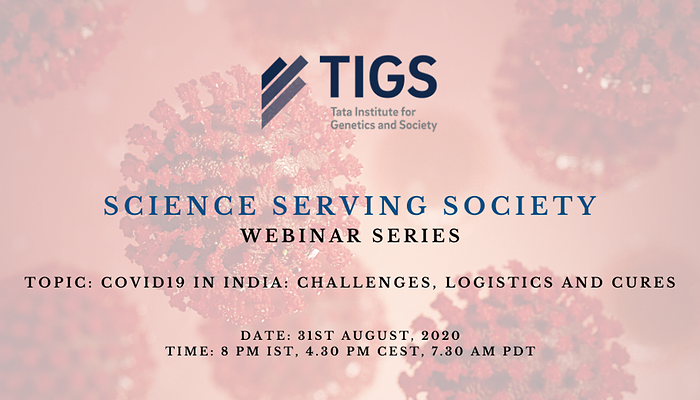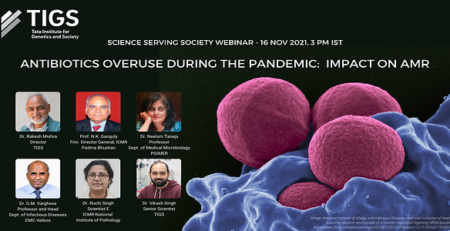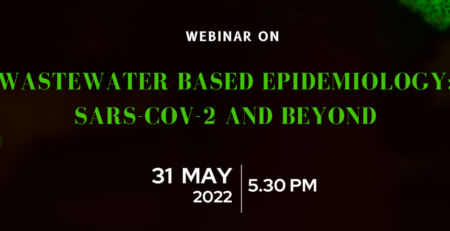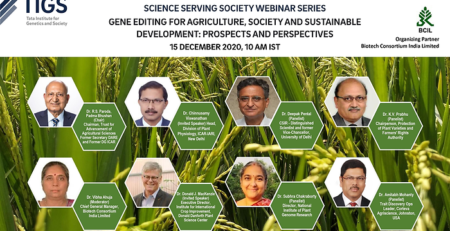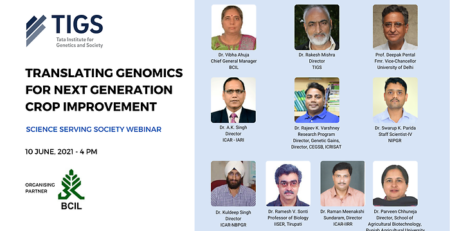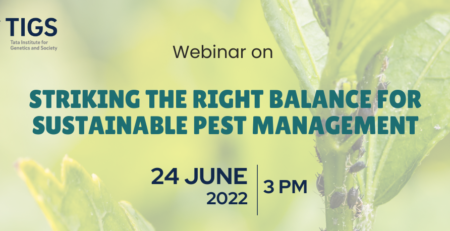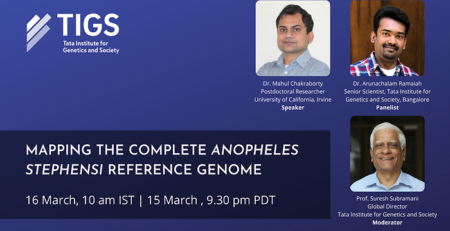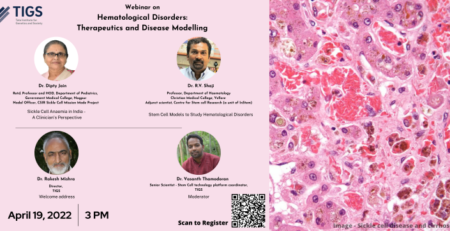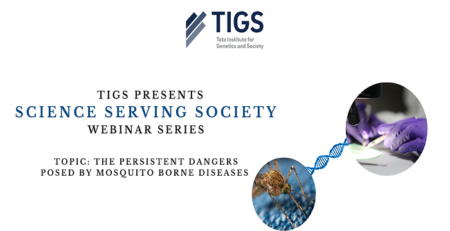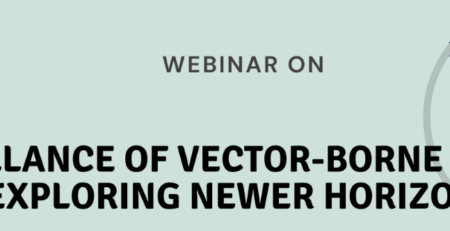Webinar recording
Highlights
The second webinar under the ‘Science Serving Society’ series was held on 31 August 2020 to discuss a subject that is extremely relevant, as the world continues to fight against COVID19. In order to take stock of the lessons we have learnt so far – both from past outbreaks and the current pandemic, and to understand the challenges in developing a vaccine – TIGS brought together a panel of three renowned experts who are involved in leading the fight.
The webinar began with our Global Director, Professor Suresh Subramani, setting the context of the conversation by quoting a 2007 research article, in which scientists studying Coronaviruses had issued a dire warning. It said that the presence of a large reservoir of SARS-CoV-like viruses in horseshoe bats is a time bomb. The possibility of the reemergence of SARS and other novel viruses should not be ignored. The outbreak which originated in Wuhan, China, quickly spread across the world, and presently, at the end of August 2020, India is the third-worst-hit country reporting the highest number of daily infections.

The first speaker, Dr Gagandeep Kang, spoke about the epidemiology of the SARS-CoV-2 virus in India and compared the trajectory of the daily number of new cases in India to the US and UK, stating that this increase in India is to be expected, considering our population of 1.3 billion people.

She compared the positive rate, the share of tests returning a positive result, of different countries. The positive rate continues to be high in countries like India, US and Mexico, indicating that we’re still not testing enough number of people.

She also spoke about how testing rate has evolved in India over the past several months, discussed results from serosurveys conducted in several parts of the country and shared her thoughts on ongoing clinical trials, regulatory approaches and ethical considerations to mull over as the world races to find a cure. Her session highlighted the need for careful analyses of relevant data in order to develop robust testing methodologies and vaccines against SARS-CoV-2 in the near future.
Following Dr Kang, Dr Soumya Swaminathan brought in a global perspective by taking the audience through how the pandemic progressed over the last eight months, since the world first heard about it in December 2019. She spoke about how genome sequences of the virus provided clues about its epidemiology and behaviour, and how scientists have been tracking the mutations of SARS-CoV-2, and correlating the data obtained from studying mutations and viral strains to work towards developing effective vaccine candidates. She emphasised the need for good, solid research to understand more about human-to-human transmission and that wearing masks, practicing hand hygiene and maintaining social distancing can contribute to flattening the curve.
Dr Swaminathan spoke about how the WHO’s Research and Development Blueprint framework, which lays out guidelines and procedures for handling diseases which can cause serious outbreaks and epidemics, was put into motion during the initial stages of the pandemic with working groups identifying priorities and knowledge gaps. She also spoke about the ACT (Access to COVID19 tools) Accelerator, which is a global collaborative effort for the development, production and equitable access to COVID19 tests, treatments and vaccines, and the COVAX facility, which is the vaccines pillar of the ACT Accelerator. Dr Swaminathan also stressed the importance of establishing the efficacy and safety of vaccines before they are licensed and enabling the selection of the most optimal vaccines for use.

The next speaker, Dr Vikram Paradkar, spoke about the vaccine efforts in India, challenges and the way forward. He began by establishing how the vaccine development process for COVID19 began on a note of urgency, and despite having the necessary expertise on how to develop vaccines against novel classes of pathogens, vaccine manufacturers across the world are facing a unique situation in the face of a global pandemic in terms of expediting a process that usually takes years. He talked about the types of vaccine candidates currently under various stages of trials, such as RNA and DNA vaccines, inactivated vaccines, live attenuated vaccines, and protein subunit vaccines and discussed how various technologies, right from gene modification to the use of nanotechnology, can aid the process of vaccine development. As an expert who is involved in developing, manufacturing and deploying a possible vaccine against SARS-CoV-2, he went on to talk about the role of global partnerships in vaccine development, the capacity, scale and commitment required to ensure global availability and his opinions from a vaccine developer and manufacturer’s perspective on the deployment of adequate doses of an effective product. He ended on a hopeful note by saying that although these are challenging times, Indian vaccine makers have the capability of living up to this challenge.

Prof Subramani then engaged the panel in a Q&A session. He touched upon the topic of ‘Vaccine Nationalism’ and the ethical concerns that arise in the distribution of an effective vaccine. When governments across the world are debating over who will get it first, every country is likely to prioritize its own citizens and only a limited number of doses might be available in the near future.

Dr Swaminathan said that to address this extremely critical issue, the WHO has developed a ‘Fair Allocation Framework and Mechanism’, which has been discussed and vetted by members of the WHO with the goal of reducing the acute impact of this pandemic, that is, the mortality rate of COVID19, by prioritising vaccinating frontline workers, social workers, the elderly and the most vulnerable populations across the world. She also added that the vaccine will be made available to countries in tranches, and the first tranche will be enough to cover 3% of each country’s population. The next tranche will ensure 20% coverage, which will secure the health of most vulnerable groups. The final aim is to ensure equitable access and sharing of vaccine resources, with a special focus on low-income countries. Dr Kang mentioned that in India a committee has been set up under NITI Aayog to ensure fair distribution of doses in the country. She also stated that ultimately, every country will make a decision for itself, but given that India has a unique population structure, it’s important that we get it right. Dr Paradkar pitched in with his thoughts too, by discussing how vaccine deployment is a fairly capital and resource intensive task that requires adequate funding, in addition to the Government and the private sector working in tandem to ensure seamless delivery.
The panel also discussed seropositivity rates, testing methodologies, herd immunity, evidence of re-infections and the possibility of ‘Twindemics’ because healthcare resources that deal with dengue, malaria, tuberculosis , immunization, maternal and infant mortality, etc. are being diverted to deal with the pandemic.
The discussion closed with Prof Subramani’s final question to Dr Swaminathan, ‘What are some of the lessons we have learned from this pandemic?’ She replied that no country in the world is prepared for a pandemic and that governments must invest in pandemic preparedness and research. India’s 2017 National Health Policy, which outlines building a public health cadre in every state, is an important step, because this will not be the last epidemic or pandemic that we see and we cannot afford to repeat the same mistakes.

